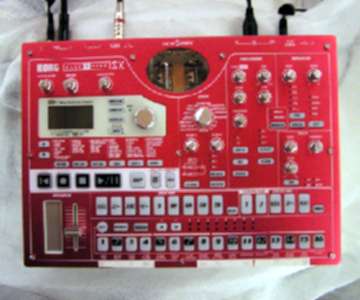Why would anyone want to perform behind the PA system? There is no reason for it since there are no microphones. When you have microphones, you have feedback issues. But an environment that’s solely set up for electronic equipment, you don’t have these problems, so why would you have people setting up behind the system? Then they are the only ones who are not hearing the sound properly. And why draw a line between audience and artist? To me it’s a rock music kind of thinking that you need someone to focus on, someone who’s more or less on the stage.
Do you often perform on the floor in front of the stage?
I always do it when possible, but more often when it’s just me alone. If it’s a band with drums, we need the stage because it’s something nice to look at. You get someone drumming in the right way and you see how it identifies with the rhythms, with the computer rhythms. It’s really nice to watch.
But with DJ equipment, and especially DJing without records, the performance can only be very poor onstage because nobody knows what’s going on. The stage is ideal for dance choreography, for theatre and for music as well, but if you can’t watch the music, if you don’t understand how they produce the music, the whole concept falls apart. If you play your tracks off the USB stick, which is technically logical and understandable because you have a much wider repertoire, and you are using CD players, I mean, there is no reason why you would perform a spontaneous mix out of fresh new tracks, it could easily be made up, especially in the environment where you have the responsibility for 2,000 people.
Do you think there’s reason to suspect those DJs?
I don’t suspect it, but you could say the situation suspects it. Imagine someone who’s not an insider, who doesn’t know about CD players, who doesn’t know about turntables—he would assume that it’s completely automatic. I’m always trying to look upon things from an outsider perspective, to get a more objective impression of what’s happening. Like an alien, extra-terrestrial point of view if you like. As far as possible, at least.
So when you’re playing and people can’t see what’s going on, that makes you uncomfortable?
Yeah, it makes me feel uncomfortable, absolutely. Ideally I would perform in an ensemble. Each sequence that is played back would be performed by someone and I would be playing my part as well. But you can imagine that this is almost impossible today.


[…] …probabilmente niente, tranne che usiamo tutti, tra le altre cose, la Korg ESX-1. […]
[…] piano la merdosa groovebox MC-303 della Roland, pilotata (male, almeno per ora) via MIDI dalla electribe rossa sullo […]
Ciao, sì, l’ESX ha una memoria interna relativamente piccola e ci si possono memorizzare 285 secondi di samples al massimo (avevo sbagliato – 285, non 250).
Il modello nuovo usa le SD card ma non legge direttamente i campioni da lì, bisogna prima importarli nella memoria interna.
Un tipo diverso di aggeggio che potrebbe tornarti utile è il Roland SP 404, che a differenza dell’ESX pare legga i campioni direttamente dalla SD card (dovresti verificarlo). Tra l’altro è più economico e portatile.
http://www.roland.com/products/en/SP-404SX
ciao. io produco beat per rap, ma vorrei anche spaziare. ho visto che l’akai mpc 5000 costa esageratamente tanto, mentre sto korg è più abbordabile. siccome me ne intendo ancora poco, dicevi che ha 250 inteso come secondi di campionamento?
saluti e grazie
in effetti dovremmo chiamarla campionatrice.
p.s.
“campionatore” è maschile, ma “l’electribe” è femminile, non so perché.